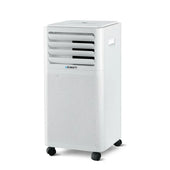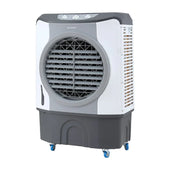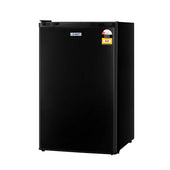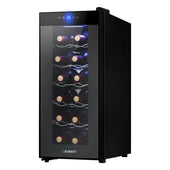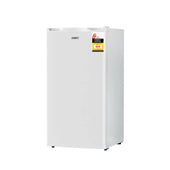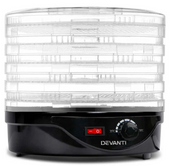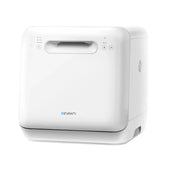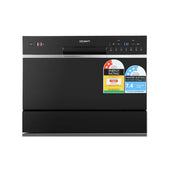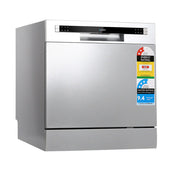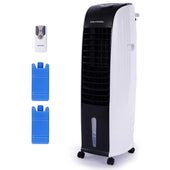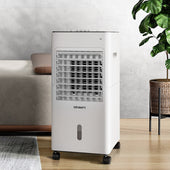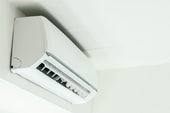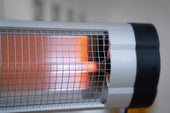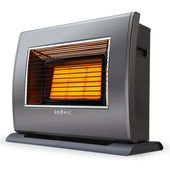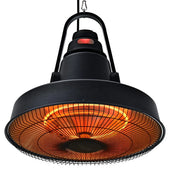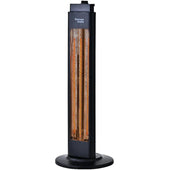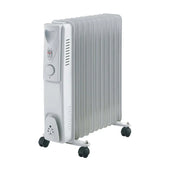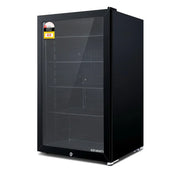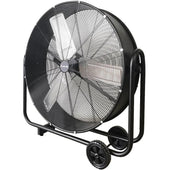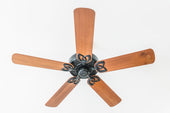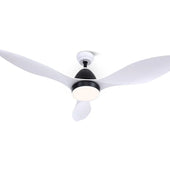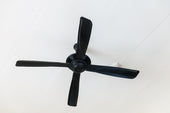Understanding the Basics: What Are AC and DC Ceiling Fans?
Ceiling fans operate using either alternating current (AC) or direct current (DC) motors, which influence their performance and efficiency.
- AC Ceiling Fans: These fans use an alternating current motor powered by the electrical grid. AC motors alternate the direction of current flow, creating a magnetic field to spin the blades. They have been widely used for decades and are generally simpler in design, making them more affordable.
- DC Ceiling Fans: DC motors rely on direct current, operating through a constant electrical flow from an external converter or driver. These fans are known for their energy efficiency, quieter operation, and ability to deliver precise speed control, offering advanced features compared to AC fans.
Understanding these distinctions is essential for choosing the right fan for specific needs and preferences.
How Do AC and DC Motors Differ in Ceiling Fans?
AC (alternating current) and DC (direct current) motors differ primarily in how they convert and utilise electrical power.
- Power Source: AC motors run directly on the alternation of electrical current from mains supply, while DC motors convert AC to DC using an inbuilt transformer.
- Energy Consumption: DC motors consume significantly less energy, often 70% less than AC motors, due to reduced power losses.
- Operation and Speed Control: AC motors require capacitors for speed adjustment, whereas DC motors rely on electronic controllers, allowing smoother, precise speed control.
- Size and Weight: DC motors are generally lighter and more compact, contributing to sleeker fan designs.
- Noise Levels: DC motors perform more quietly due to fewer mechanical parts in their operation.
Understanding these distinctions enhances decision-making for choosing a suitable fan type.
Energy Efficiency: Which Fan Type Saves More Electricity?
The energy efficiency of ceiling fans largely depends on their motor type. DC ceiling fans operate on direct current, consuming significantly less electricity compared to AC ceiling fans, which rely on alternating current.
Benefits of DC fans include:
- Lower power consumption: DC fans use up to 70% less energy than AC fans for the same airflow.
- Variable speed control: They often include more precise speed variations, supporting efficient energy usage.
On the other hand, AC fans, while generally less efficient, may still offer decent energy savings in smaller or budget models. Choosing the right fan type depends on energy priorities and specific usage needs.
Performance and Speed Control: AC vs DC Fans
AC fans utilise alternating current, which directly influences the rotation speed by altering the frequency of power supplied. This often results in limited speed variations and slightly less precise control. DC fans, on the other hand, rely on direct current, allowing for advanced electronic control over the motor.
- Speed Precision: DC fans typically offer a broader range of speed settings, usually with 6 or more options, compared to AC fans' standard 3-5 settings.
- Performance Stability: DC fans maintain consistent speeds under various voltage fluctuations, while AC fans might waver slightly.
Enhanced control features, such as remote operation, are far more common in DC fan models.
Noise Levels: A Quiet Spin or a Humming Concern?
When evaluating ceiling fans, noise levels significantly impact user satisfaction. At During Days, DC ceiling fans are generally quieter during operation due to their innovative brushless motor technology. The lack of brushes results in reduced friction and sound, making them ideal for bedrooms, studies, and offices.
AC ceiling fans, on the other hand, may produce a faint humming noise, especially at higher speeds. This hum originates from the electromagnetic frequency in the alternating current and the vibration of internal components.
For those sensitive to sound or requiring a quieter environment, DC fans stand out as the preferred choice. However, the noise differences may go unnoticed in lively or open spaces.
Initial Cost and Long-Term Savings: What’s the Better Investment?
When considering ceiling fans, the initial cost and long-term savings differ significantly between DC and AC models.
- Initial Cost: DC ceiling fans tend to have a higher upfront cost compared to their AC counterparts due to the advanced technology they employ and their energy-efficient motors. AC fans, being more conventional, are generally more affordable, which could appeal to those on tighter budgets.
- Operating Costs: DC fans consume significantly less energy, translating to lower electricity bills over time. On average, DC motors use 60%-70% less power than AC motors. This makes them ideal for continuous or long-term usage.
- Durability: Many DC fans boast longer lifespans, reducing maintenance costs. AC units may require more frequent servicing due to wear and tear, which can offset initial savings.
Design and Aesthetic Options for AC and DC Ceiling Fans
AC and DC ceiling fans offer various design options to suit diverse interior styles. Both types come in a range of finishes, such as brushed nickel, matte black, woodgrain, or polished chrome, catering to contemporary and traditional aesthetics.
Many AC fans feature classic, bulkier designs often preferred for larger spaces, while DC fans tend to have sleeker, minimalist styles aligned with modern decors. Blade materials and shapes vary, including curved or geometric options to complement architectural themes.
Lighting integration is another consideration, with many AC and DC fans offering built-in LED light kits. Customisation options, like interchangeable blades and colour choices, enhance versatility.
Installation and Maintenance Considerations
Installing a DC ceiling fan often requires a compatible controller or remote, which may demand more attention during setup than traditional AC fans. However, their lightweight design can simplify the physical installation process. AC ceiling fans tend to operate on standard electrical wiring, making installation relatively straightforward for electricians or those with basic wiring knowledge.
In terms of maintenance, DC fans' brushless motors experience less wear and tear, leading to reduced servicing needs over time. Conversely, AC motors may require occasional lubrication and checks for noise or vibration issues. Cleaning should include regular dusting of blades and motor housings to ensure optimal performance for both types.
Environmental Impact: Sustainability of AC and DC Fans
When examining the environmental impact of AC and DC fans, their energy consumption emerges as a critical factor. DC fans are known to consume significantly less energy than their AC counterparts, often requiring up to 70% less power. This leads to lower carbon emissions when powered by grid electricity.
DC motors also tend to produce less heat during operation, which may extend their lifespan and reduce the demand for frequent replacements. On the other hand, AC fans utilise simpler, more readily available components, making repairs and recycling more feasible. Sustainability considerations also include the availability of recyclable materials in both fan types.
Energy efficiency plays a pivotal role in overall resource conservation. DC fans, through their reduced power requirements, align more closely with eco-friendly energy standards and renewable integration, while AC fans rely on established, less energy-efficient technologies.
Smart and Remote Control Features: Is One Superior?
DC ceiling fans and AC ceiling fans differ significantly in their control options, catering to various user preferences. DC fans often boast advanced smart features such as compatibility with Wi-Fi, Bluetooth, or voice assistants like Alexa and Google Home. These fans typically come with sophisticated remote controls allowing precise speed adjustments and additional modes, such as sleep or eco mode.
AC fans, on the other hand, offer more traditional remote control systems. Their remotes cover basic functions, such as turning the fan on/off and adjusting speed. However, integration with smart home systems or app-based controls is less common in AC models.
In essence, DC fans generally provide enhanced smart connectivity and a more modern control experience.
Practical Use Cases: Which Type Fits Your Needs?
Choosing between DC and AC ceiling fans depends on specific scenarios and user priorities.
- Energy Efficiency: DC fans are ideal for energy-conscious users, especially in areas with high utility costs or for those aiming to lower overall consumption.
- Quiet Operation: DC fans suit bedrooms, libraries, and offices due to their quieter motors, reducing noise disruption.
- Cost Considerations: AC fans are preferable for budget-conscious buyers seeking affordable upfront purchases without prioritising long-term savings.
- Remote Access: DC fans are more suited for modern homes requiring advanced remote-controlled or smart features.
- Durability & Simplicity: AC fans work best in high-usage settings like workshops and public areas, where durability and maintenance ease are essential.
Durability and Lifespan: Comparing Longevity
DC ceiling fans generally exhibit greater durability due to their advanced motor technology and reduced wear on internal components. Their brushless motors result in fewer moving parts, decreasing the chances of mechanical failure over time. Additionally, they generate less heat during operation, further enhancing motor lifespan.
In contrast, AC ceiling fans tend to have a shorter lifespan due to the use of brushed motors, which experience more wear and tear. Prolonged use can lead to higher maintenance needs, such as replacing brushes or dealing with overheating issues.
When properly maintained, DC fans usually outlast AC fans, offering superior long-term reliability.
Weighing the Pros and Cons of AC Ceiling Fans
AC ceiling fans are powered by alternating current, the standard electricity supplied by most mains systems. They are widely recognised for their affordability and simplicity.
Advantages:
- Cost-effective: AC fans generally have a lower upfront cost compared to DC models.
- Availability: They are more commonly found and available in various styles and sizes.
- Simplicity: AC fans are easy to install and repair due to standardised components.
Disadvantages:
- Energy efficiency: AC fans consume more electricity compared to DC models, leading to higher energy bills.
- Noise levels: AC fans may generate more noise, especially when operating at high speeds.
- Limited control: They often lack advanced speed settings and smoother operation features present in DC fans.
Deciding on an AC ceiling fan involves evaluating these factors in conjunction with personal needs.
Weighing the Pros and Cons of DC Ceiling Fans
DC ceiling fans come with a variety of advantages and some drawbacks that homeowners should consider. Below are key aspects to evaluate:
Pros:
- Energy Efficiency: DC fans consume up to 70% less energy compared to AC fans, making them an ideal choice for reducing electricity bills.
- Quiet Operation: These fans are designed for minimal noise, providing a peaceful environment, especially in bedrooms or study areas.
- Variable Speed Control: With more precise speed settings, users can customise airflow to suit their preferences.
- Compact Motors: Their motors are smaller and lighter, allowing for sleeker, modern fan designs.
- Reverse Functionality: Many models include reverse settings for summer or winter use, improving energy efficiency year-round.
Cons:
- Higher Cost: DC fans are typically more expensive upfront due to advanced technology and design.
- Complex Repairs: Servicing or repairing DC fan motors may be costlier and require specialised technicians.
- Limited Availability: They may not be as widely available as traditional AC fans, limiting options in certain regions.
Evaluating these factors helps determine if a DC fan fits individual needs and budget.
Final Thoughts: Which Ceiling Fan Should You Choose?
When deciding between DC and AC ceiling fans, several factors come into play. DC fans are ideal for those prioritising energy efficiency, quieter operation, and modern designs. They consume significantly less power and often include advanced features such as remote control and adjustable speed settings. On the other hand, AC fans are more budget-friendly and have proven reliability over decades of usage, making them suitable for homeowners seeking cost-effective solutions.
Consider the room size, intended use, and your budget. DC fans may be more suitable for light commercial spaces or areas demanding aesthetic appeal, while AC fans are versatile and dependable for most residential use cases.






